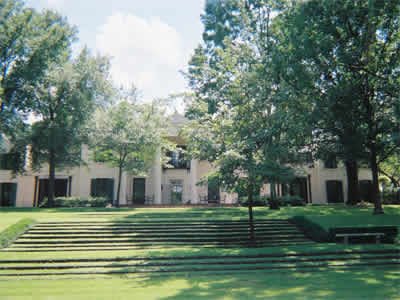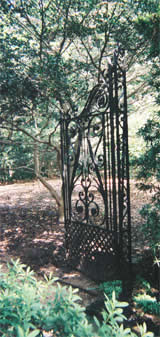 |
 |
 |
|
News & Notices
News From:
Commissions
Conference & Stage Expo
For the Record
 |
Bayou Bend, the experiment in fine living created by the Hogg family in Houston, Texas is now home to a renowned collection of decorative arts.
|
|
|
Hogg Home Offers Many
Delights for Designers For years, everyone heard the joke about an unfortunate girl in the South (sometimes it was Georgia, sometimes Alabama) whose last name was Hogg. Her parents named her Ima. Gotta be a joke, right? Who in their right mind would actually do that to their child? Those who attend the USITT 2008 Annual Conference & Stage Expo will find the answer to that question, close to downtown Houston, Texas. Ima Hogg, renowned Houston philanthropist and one of the founders of the Houston Symphony, was born in a very small town in Texas in 1882. After having three boys, her parents were so thrilled to have a girl, they named the baby in honor of the heroine of a Civil War poem written by her uncle (Ima being a "pet" name for Imogene.). The story goes that when the baby's name was told to her grandfather, he ran all the way to the parents' home to talk them out of the unfortunate choice but to no avail. Fortunately, "Miss Ima" was apparently never openly plagued by her name. She grew up in a privileged atmosphere as the daughter of a Texas governor to attend the University of Texas; and, after graduating from college in 1901, Ima traveled to New York and Vienna to study music before returning to the newly oil wealthy Houston. Ima began collecting decorative arts in 1920 with a colonial, American-made Queen Anne armchair after admiring one she had seen in an artist's studio in New York. This piece was the start of an "unaccountable compulsion" for Miss Ima. She continued to acquire American pieces circa 1640 to 1870 over the next half century resulting in one of the foremost assemblages in the nation. Ima, along with brothers Will and Mike, built Bayou Bend in 1927-28 as part of a grand experiment in fine living. The home was designed by John F. Staub and reflects a combination of influences from the symmetry of Georgian architecture to the lush, romantic qualities of the Spanish Creole of New Orleans to the functional but exquisite characteristics of typical southern plantations. In fact, the wrought iron balcony prominent on the southern exposure of the house was salvaged from a Big Easy structure. Miss Hogg labeled the home's style as "Latin Colonial." Miss Hogg knew from the beginning that Bayou Bend would provide the setting for her ever-growing and increasingly important collection of American decorative arts. So Mr. Staub, as part of his approach for Bayou Bend, created simple but stately rooms where the pieces could be shown to their best advantage. In 1957, Miss Ima donated her collection, along with the house and grounds, to the Museum of Fine Arts Houston with the understanding that her home would be converted into a house museum. "While I shall always love Bayou Bend and everything there, in one sense I have always considered I was only holding my collection in trust." Miss Hogg said. And that collection is one worth making time to see! The 27-room house is arranged so that each room represents a specific time period with all of the accoutrements of that time. Not only are there exceptionally fine examples of American upholstered and fine wood furniture, but needlework topped gaming tables with early 19th century playing cards, tea tables with scallops to accommodate the numerous handle-less cups in the Chinese tradition, fine silver pieces from as early as the 17th century, wool moiré hangings representative of what would be typical on an 18th century bed, blue and white Dutch ceramics, countless magnificent portraits, and amazingly beautiful clocks. Although the scale here is much smaller (so close you can almost touch the pieces), the quality rivals that of the Period rooms at the Metropolitan Museum of Art. For those who fancy gardens, Bayou Bend is surrounded by 14 acres of cultivated landscapes with appropriate statuary, fountains, grass terraces, and hedge walls. It is an almost natural feeling woodland given that the entire property sits only three miles from the shiny, bronzed glass and stolid gray steel of downtown Houston. If the azaleas are in bloom, which happens beginning in March, Bayou Bend will literally take your breath away. Although the countryside to the east, south, and west of Houston is pancake flat, the bayous have created a lovely viridian and rolling quality to the River Oaks area where Bayou Bend was built. Those who like to visit such places on their own or who have a fairly good foundation in decorative arts, can take advantage of the audio tour. However, make the reservation for the 90 minute guided tour which is well worth the effort. The docents train for at least a year prior to their first solo guide experience. A word of caution; this is not the place for children. In fact, if they are under 10, they may have free reign of the grounds but won't be permitted inside the house. Admission is a reasonable $10 for adults and Bayou Bend is open Tuesday through Sunday with an additional $3 if you want to wander through all of the grounds. The house is located at 1 Wescott just off Memorial Drive to the west of downtown. There is no direct bus route, but a group in a taxi from one of USITT's Conference hotels will find the trip worthwhile. "Bayou Bend may serve as a bridge to bring us closer to the heart of an American heritage which unites us," Miss Hogg stated as her dream for her collection. Those who have a moment of free time next March can take the opportunity to judge the bridge she created. |
This gate is an example of the art which decorates the gardens of Bayou Bend in Houston, Texas.
 |
|
United States Institute for Theatre Technology, Inc.:
© 2007 Volume XLVII, Number 10